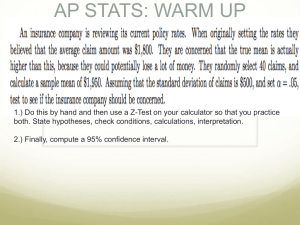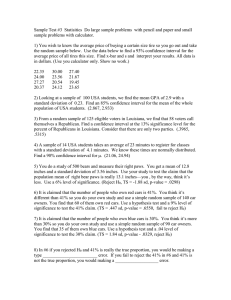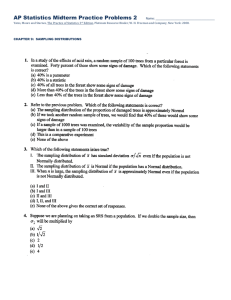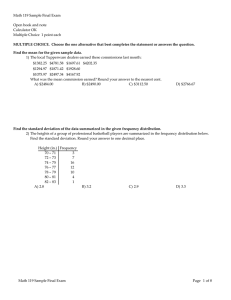Math 1070 Exam 2A 22 March, 2013
advertisement
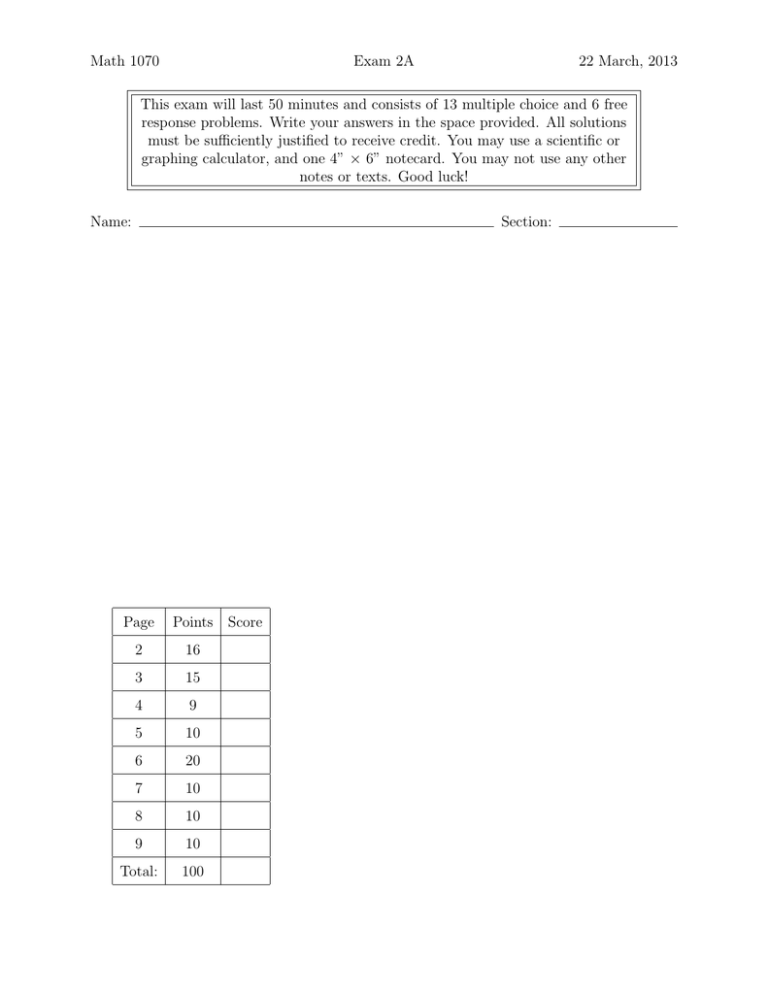
Math 1070
Exam 2A
22 March, 2013
This exam will last 50 minutes and consists of 13 multiple choice and 6 free
response problems. Write your answers in the space provided. All solutions
must be sufficiently justified to receive credit. You may use a scientific or
graphing calculator, and one 4” × 6” notecard. You may not use any other
notes or texts. Good luck!
Name:
Section:
Page
Points Score
2
16
3
15
4
9
5
10
6
20
7
10
8
10
9
10
Total:
100
Multiple Choice: Choose the answer choice that is either most accurate or best answers
the question. Write your answer on the answer sheet provided.
1. (3 points) A random variable can take any value between 0 and 2 (i.e. any value in the
interval [0, 2]). What type of random variable is this?
A. Continuous
B. Discrete
C. Hamiltonian
2. (3 points) Zoe calculates a 95% confidence interval for µ as 54.2 ± 3. If she is testing
the hypotheses
H0 : µ = 52 vs. Ha : µ 6= 52,
should she reject the null hypothesis at α = .05 significance level?
A. No
B. Yes
C. Not enough information
3. (3 points) Cookie Monster prefers to choose the letter of the day randomly. He calculates
5
. This means that
that the probability of choosing a vowel is 26
A. If he chooses 26 letters of the day, exactly 5 of them will be vowels.
B. If he chooses 26,000 letters of the day, exactly 5,000 of them will be vowels.
C. If he chooses thousands of letters of the day, the fraction of them
5
.
that are vowels will be very close to 26
4. (4 points) Consider a class survey of 269 individuals in which students claimed to study
an average of 355 minutes on a typical weeknight. The population standard deviation is
found to be 65 minutes. Regard these students as an SRS from the population of all firstyear students at this university. Does the study give good evidence that students claim
to study more than six hours per night on the average? State the null and alternative
hypothesis.
A. H0 : µ = 360 min.
vs.
HA : µ > 360min.
B. H0 : µ = 360 min.
vs. HA : µ < 360min.
C. H0 : µ = 360 min.
vs. HA : µ 6= 360min.
D. H0 : µ = 355 min.
vs. HA : µ > 360min.
5. (3 points) The Nurses’ Health Study has interviewed a sample of more than 100,000
female registered nurses every two years since 1976, from the population of all registered
nurses. The study finds that “light-to-moderate drinkers has a significantly lower risk of
death” than either nondrinkers or heavy drinkers. The Nurses’ Health Study is
A. an observational study.
B. an experiment.
C. a Control group.
D. Can’t tell without more information.
Page 2
6. (3 points) The Community Intervention Trial for Smoking Cessation asked whether a
community-wide advertising campaign would reduce smoking. The researchers located
11 pairs of communities, each pair participated in the advertising campaign and the
other did not. This is
A. an observational study.
B. matched pairs experiment.
C. a Control group experiment.
D. a completely randomized experiment.
7. (3 points) A committee on community relations in a small town plans to survey local
businesses about the importance of muppets as customers. From telephone book listings,
the committee chooses 150 businesses at random. Of these, 73 return the questionnaire
mailed by the committee. The population for this study is
A. the 150 businesses chosen.
B. the 73 businesses that returned the questionnaire.
C. all businesses in the college town.
8. (3 points) A study of voting chose 663 registered voters at random shortly after an
election. Of these, 72% said they had voted in the election. Election records show that
only 56% of registered voters voted in the election. 72% is a
A. sampling distribution.
B. parameter.
C. statistic.
9. (3 points) When rolling a fair die, each digit {1, 2, 3, 4, 5, 6} is equally likely to occur.
What is the probability that you roll the die and get a six?
A.
5
36
B.
1
36
C.
1
6
D.
1
2
10. (3 points) You want to choose a SRS of 5 of the 7200 salaried employees of a corporation.
You label the employees 0001 to 7200 in alphabetical order. Using line 111 of table B,
your sample contains the employees labeled
A. 6694, 0513, 0929, 7004, 1271.
B. 6694, 5130, 0041, 2712, 3827.
C. 8148, 6694, 8760, 5130, 9297.
Page 3
11. (3 points) Can changing diet reduce high blood pressure? Vegetarian diets and low-salt
diets are both promising. Men with high blood pressure are assigned at random to four
diets: (1) normal diet with unrestricted salt; (2) vegetarian with unrestricted salt; (3)
normal with restricted salt; and (4) vegetarian with restricted salt. This experiment has
A. one factor, the choice of diet.
B. four factors, the four diets being compared.
C. two factors, normal/vegetarian diet and unrestricted/restricted salt.
12. (3 points) A sample of households in a community is selected at random from the telephone directory: In this community, 4% of households have no telephone, 10% have
only cell phones, and another 25% have unlisted telephone numbers. The sample will
certainly suffer from
A. undercoverage
B. nonresponse
C. false response
13. (3 points) The most important condition for sound conclusions from statistical inference
is usually
A. that the population distribution is exactly normal.
B. that the data contain no outliers.
C. that the data can be thought of as a random sample from the population of interest.
Page 4
Probability
14. (10 points) The Count is rolling two fair, six-sided dice.
(a) Is this a discrete or continuous distribution?
Solution: Discrete
(b) What is the probability of rolling the two dice and having the sum be 3, 4, or 5?
Solution:
P (3) + P (4) + P (5) =
9
2+3+4
=
36
36
(c) What is the probability of rolling the dice and not having the sum be 3 or 4?
Solution:
1 − (P (3) − P (4)) = 1 −
Page 5
2
3
+
36 36
=1−
31
5
=
36
36
Sampling Distributions
15. (10 points) A sample of size 81 is taken from a population which is known to have a
normal distribution with mean 100 and standard deviation 7.
(a) What is the distribution of the sample mean, X?
Solution: N(100,
√7 )
81
(b) Compute the probability that X ≥ 110.
Solution:
X̄ − 100
110 − 100
P (X̄ ≥ 110) = P
≥
7/9
7/9
= P (N (0, 1) ≥ 12.857)
= 1 − P (N (0, 1) ≤ 12.857)
≈1−1=0
16. (10 points) A sample of size 16 is taken from a population which is Normally distributed
with mean µ and standard deviation 5. The researchers studying the population find
that X = 13.
(a) Compute a 95% confidence interval for µ using the statistic X.
Solution:
5
σ
x̄ ± Z √ = 13 ± 1.960
4
n
= 13 ± 2.45
= [10.55, 15.45]
∗
(b) Interpret your confidence interval from part a.
Solution: We are 95 % confident that the true population mean µ will fall in
the above confidence interval.
Page 6
Hypothesis Testing
17. (10 points) A sample of size 144 is taken from a population which is known to have a
normal distribution with mean µ and standard deviation 3, where µ is unknown. X̄ is
computed from the sample and is equal to 15. We wish to test
H0 : µ = 14.5 vs. HA : µ < 14.5
Compute the p-value for this test and then decide if you can reject the null hypothesis
at significance level 0.05.
Solution:
Z=
15 − 14.5
;
3/12
P (N (0, 1) < 2) = 0.9772
The p-value is much larger than our significance level. Thus, we fail to reject the
null hypothesis at significance level α = 0.05.
Page 7
18. (10 points) A sample of size 101 is taken from a population which is known to have a
normal distribution with mean µ and standard deviation σ, where µ is unknown and
σ=4. The sample mean is computed and is equal to 15. We wish to test
H0 : µ = 14.5 vs. HA : µ > 14.5
Compute the p-value for this test and then determine if you can reject the null hypothesis
at the significance level 0.15
Solution:
15 − 14.5
√
= 1.256
4/ 101
P (N (0, 1) > 1.256) = 1 − P (N (0, 1) < 1.256)
= 1 − 0.8953 = 0.1047
Z=
Thus, we have sufficient statistical evidence to reject the null hypothesis at significance level α = 0.15.
Page 8
19. (10 points) Statisticians prefer large samples. Describe briefly the effect of increasing
the size of a sample (or the number of subjects in an experiment) on each of the following:
a) (5 points) The margin of error of a 95% confidence interval.
Solution: The margin of error will decrease.
b) (5 points) The P-value of a test, when H0 is false and all facts about the population
remain unchanged as n increases.
Solution: The p-value decreases (the evidence against H0 becomes stronger).
Page 9
Bonus Question
20. (10 points (bonus)) A sample of size 81 is taken from a population which is known to
have a normal distribution with mean µ and standard deviation 7, where µ is unknown.
Compute the probability of X̄ − µ being between -2 and 2.
Solution:
−2
X̄ − µ
2
√ ≤
P (−2 ≤ X̄ − µ ≤ 2) = P
≤
7/9
7/9
σ/ n
= 0.9949 − 0.0051
= 0.9898
Page 10


